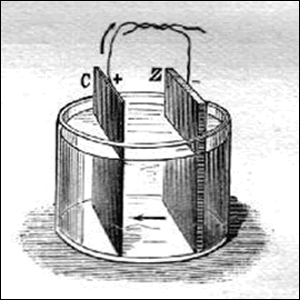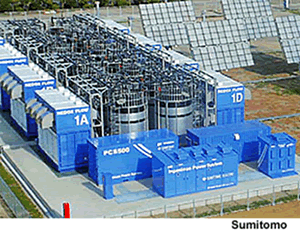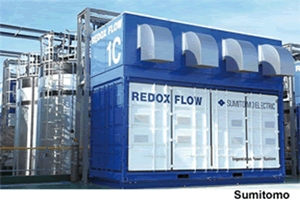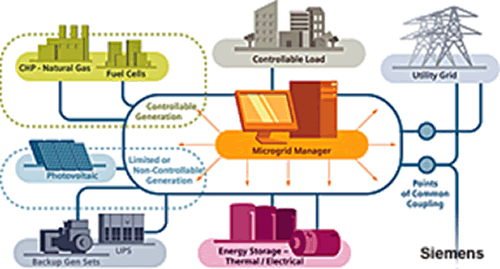Utility Scale Energy Storage Boosts Alternative Sources
Advances in battery technology developed for utility scale energy storage present opportunities for power connector suppliers.
 The humble battery, along with advances in wireless communication technology, has enabled a revolution of mobile electronic devices that no longer require a copper tether for either signal or power. Improvements in energy density, discharge rate, operating temperature range, recharge cycles, and miniaturization enabled the surge of laptops, notebooks, and e-readers, as well as the ubiquitous smartphone.
The humble battery, along with advances in wireless communication technology, has enabled a revolution of mobile electronic devices that no longer require a copper tether for either signal or power. Improvements in energy density, discharge rate, operating temperature range, recharge cycles, and miniaturization enabled the surge of laptops, notebooks, and e-readers, as well as the ubiquitous smartphone.
 There have been a few bumps along that road. Some lithium-ion (Li-ion) batteries created reliability and even safety problems, as many laptop, hoverboard, and Samsung smartphone users discovered.
There have been a few bumps along that road. Some lithium-ion (Li-ion) batteries created reliability and even safety problems, as many laptop, hoverboard, and Samsung smartphone users discovered.
At the other end of the scale, designers of electrical distribution grids are looking at the possibility of using batteries to solve a basic limitation of alternative energy sources.
Wind and Solar Offer Promise and Challenges
Wind and solar energy generation has grown dramatically over the past 10 years as wind generators have become larger and solar cell efficiency has increased. Large swaths of prairie are now carpeted with immense arrays of solar panels. Complaints about noise, visual pollution, and danger to migrating birds have not slowed the growth of large wind farms. Until we are able to achieve economical fusion, wind and solar power generation represent the most environmentally benign solutions available today.
The problem with both wind and solar energy production is that they are intermittent sources, while energy demand is a 24/7 proposition. Cloudy days and nighttimes take solar energy off the table. Wind farms are built in locations where wind is more consistent, but the degree of wind is constantly changing, making electrical energy generated by the wind variable. Our current system of power distribution is based on the premise that electricity must be used as it is produced. The fact that demand can vary considerably requires that supply be instantly capable of supporting peak demand. This requires expensive excess generation capacity and a distribution system that must be constantly monitored and adjusted to deliver what is needed — no more or less.
Building backup power generation capacity using conventional coal or natural gas fuels to supplement wind and solar power when it is not available is a poor use of capital. The result is costly back-up generating capacity that may sit idle for hours or days depending on demand.
A better solution would be the ability to store electrical energy collected when low cost, environmentally friendly energy is available and releasing it back into the grid when it is not. Such a system could be used to better balance power distribution between fluctuating supply and demand. A distributed network of buffers capable of rapidly charging and discharging megawatts of power to the grid could also minimize the effects of cascading power outages, as well as maintain service when equipment fails or is sabotaged.
Battery Advances Show Potential for Grid-Attached Applications
 Advances in battery chemistry and automated power management systems are beginning to make that possible. Scaled-up lithium ion batteries have emerged as an early contender in grid-attached utility-scale storage applications. Other types, such as zinc-flow, are already in commercial production. Battery technologies must provide a combination of low cost per kilowatt hour, long service life, high energy density, and high efficiency during charge/discharge cycles, and must also be operator- and environmentally safe. Creating a system to control the electrochemical process of an industrial zinc-flow battery, as well as to regulate and synchronize direct current power of multiple connected sources for delivery onto the AC power grid is a system management challenge. This will require a network of secure, real-time data communication links.
Advances in battery chemistry and automated power management systems are beginning to make that possible. Scaled-up lithium ion batteries have emerged as an early contender in grid-attached utility-scale storage applications. Other types, such as zinc-flow, are already in commercial production. Battery technologies must provide a combination of low cost per kilowatt hour, long service life, high energy density, and high efficiency during charge/discharge cycles, and must also be operator- and environmentally safe. Creating a system to control the electrochemical process of an industrial zinc-flow battery, as well as to regulate and synchronize direct current power of multiple connected sources for delivery onto the AC power grid is a system management challenge. This will require a network of secure, real-time data communication links.
An interesting consequence of the electric car evolution is the concept of the car as a battery that can supplement the grid. An electric vehicle plugged into a grid-connected charger can be considered a battery on wheels. Large numbers of charged vehicles could act as widely distributed energy storage points that could bridge the gap between peak rate time periods and availability of wind and solar electrical production. Current consumer automotive chargers are not capable of providing this vehicle-to-grid function, but they offer an interesting glimpse of how the expansion of one technology (personal electric vehicles) could have a major impact in another (alternative energy adoption).
Continued expansion of solar energy production is spurring interest in the use of direct current (DC). Solar panels generate DC power, and vehicle batteries use DC power to charge. There is no need for a costly and inefficient DC to AC conversion process. The advantages of using DC electric power are at the heart of the Emerge Alliance, an industry consortium formed to create and promote the adoption of standards for the distribution of DC power in commercial buildings. Edison would be pleased.
Demand for Reliable Interconnects Will Rise Throughout the Grid
 The storage and distribution of energy generated from alternative sources will impact the world of electrical and electronic connectors. Proliferation of electric vehicles will require millions of commercial and residential charging stations and will create demand for new internal power management connector systems, as well as touch-proof high-voltage connectors that deliver power and monitor the charging process. At the utility level, the smart grid initiative will drive more electronic communication and automation. Thousands of sensors deployed both in the grid and throughout homes will monitor performance and constantly adjust systems for maximum efficiency and reliability. This will require low-voltage signal, high-current, and high-voltage connectors.
The storage and distribution of energy generated from alternative sources will impact the world of electrical and electronic connectors. Proliferation of electric vehicles will require millions of commercial and residential charging stations and will create demand for new internal power management connector systems, as well as touch-proof high-voltage connectors that deliver power and monitor the charging process. At the utility level, the smart grid initiative will drive more electronic communication and automation. Thousands of sensors deployed both in the grid and throughout homes will monitor performance and constantly adjust systems for maximum efficiency and reliability. This will require low-voltage signal, high-current, and high-voltage connectors.
As alternative sources of electrical power generation become a larger percentage of total production capacity, energy storage will likely increase to ensure use of the most cost-effective resource. Adding grid-scale storage at generating stations and many distributed points will minimize the need for building back-up capacity, as well as reduce the potential for power interruptions. Connectors will be required for both high current handling circuits and the computer automated controllers that will manage charge and discharge cycles. Generation, storage, and transmission elements of the grid will require network communications to ensure balance and reliability, opening more interconnect opportunities. Speed, reliability, and hack-proof advantages of optical links will increase their use in system management links.
Current utility scale energy storage is not cheap, but the momentum for green power continues to grow. California has become the leader in building prototype systems that test storage and software for greatest efficiency.

The “virtual power plant”.
The “virtual power plant” is a locally based microgrid that consists of both conventional and alternative energy sources connected to battery storage and managed by a computer network.
At the utility level, Pacific Gas and Electric is currently testing two megawatt-scale battery storage systems to determine technical and economic viability. All of these systems will require reliable interconnects that represent new opportunities for rugged low and high-power connectors.
Energy Storage on the Smart Grid Offers Excellent Growth Potential for the Connector Industry
Recently posted:
[related_posts limit=”10″]
- Digital Lighting Enhances your Theatrical Experience - March 5, 2024
- DesignCon 2024 in Review - February 13, 2024
- Chip Technology Struggles to Keep Pace with Moore’s Law - January 30, 2024






